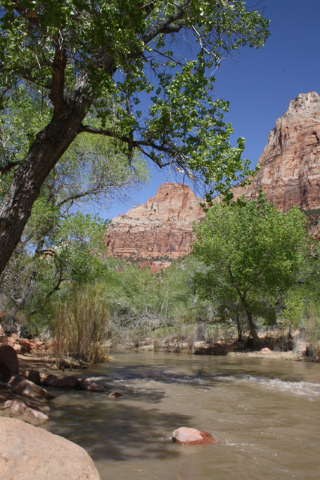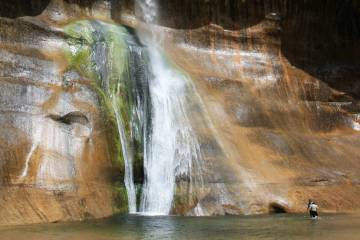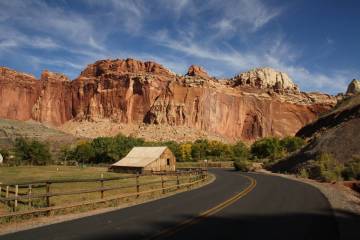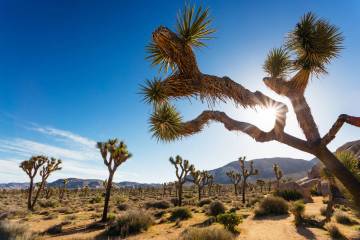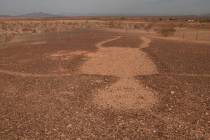Outdoors: Zion plans numerous hands-on learning events this time of year
Over the next month or so is one of the finest times to enjoy Zion National Park, Utah. The weather is ideal; the leaves are popping out on the deciduous trees; wildflowers are appearing; and the birds are out and about enjoying springtime.
Of course, it will be spring in Las Vegas also, but making a pleasant three-hour drive to Zion offers the opportunity to become more expert in your favorite aspects of outdoor life through educational events sponsored by the Zion Canyon Field Institute. They range from lectures to custom adventures, from single- to multi-day events, but all are presented in lovely outdoor settings. Though the institute operates year-round, the next six weeks offer more of these experiences than any other time of year.
Thursday Treks: From 9 a.m. to 2 p.m. March 31 and April 14, a naturalist will take participants out in the field so they can get an introduction to the flora, fauna, geology and cultural history of the park. Ages 15 or older. The cost is $45.
Spring Birds in Zion: From 8 a.m. to noon April 2, participants can spend the morning observing birds along the Virgin River, where a vast variety can be found. This time of year, you will see both migrants passing through and year-round resident species. Learn about bird behavior and other interesting aspects of Zion’s natural history. For ages 16 or older. The cost is $45.
Mojave Wildflowers: From 9 a.m. to 4 p.m. April 9, this workshop departs from the St. George Bureau of Land Management Office to find the perfect area for blooming wildflowers. April is usually the banner month to see wildflowers in the Mojave Desert, and it should be especially so this year when winter rainfall has been plentiful. For ages 15 or older. The cost is $65.
Low Desert Wildflowers: From 9 a.m. to 3:30 p.m. April 16, this field trip will take you to the only small section of the Mojave Desert contained in the park, in its extreme southwest corner. You will find a rich variety of wildflowers, cactus and flowering shrubs among some of the finest scenery in Utah. For ages 15 or older. The cost is $60.
Zion through The Lens: From 9 a.m. to 7 p.m. April 16 and 17, this two-day workshop concentrates on using your camera in full manual mode. Other topics include use of filters, composition, controlling depth of field and use of tripods. A 2½-hour break is planned at noon. For ages 16 or older. The cost is $225.
Archaeological Field Day: From 9 a.m. to 3 or 4 p.m. April 21, spend the day with a Zion archaeologist. Participants might take part in survey work, cataloging and other tasks depending on what is needed. Be prepared to hike. For ages 16 or older. The cost is $60.
Zion Geology: From 9 a.m. to 4 p.m. April 23, the day will focus on the ongoing geologic processes in the park. Short hikes will explore landslides and rock falls and the power of water in shaping the canyon. For ages 15 or older. The cost is $60.
The meeting place for the workshops, unless otherwise noted, is at the Zion National Park Human History Museum, just inside the park’s entrance. All participants should be dressed appropriately for hiking and changes of weather. Wear good walking shoes or boots, and wear layers of clothing to peel and put on again as temperatures fluctuate throughout the day. Bring all necessary personal items such as your camera, binoculars, sunscreen, water, lunch and snacks. Minimum age requirements vary. Reservations for classes and workshops are necessary, and they fill up fast. Contact The Zion Canyon Field Institute by visiting zionpark.org or calling 800-635-3959 or 435-772-3264.
Deborah Wall is the author of “Great Hikes, A Cerca Country Guide” and “Base Camp Las Vegas: Hiking the Southwestern States,” published by Stephens Press. She can be reached at deborabus@aol.com.
Directions to Zion
From Las Vegas, take Interstate 15 north 125 miles to Utah state Route 9 (Exit 16 - Hurricane/Zion National Park). Follow Route 9 east for 32 miles to Springdale, Utah, and Zion National Park.




